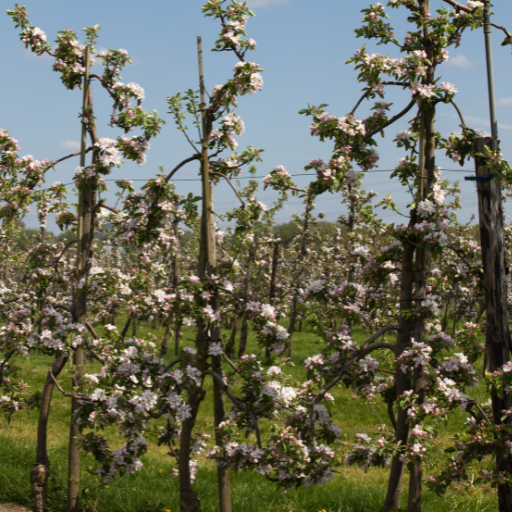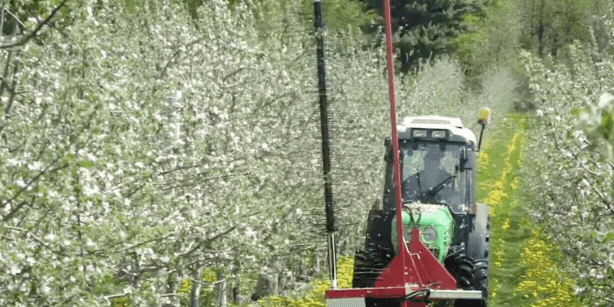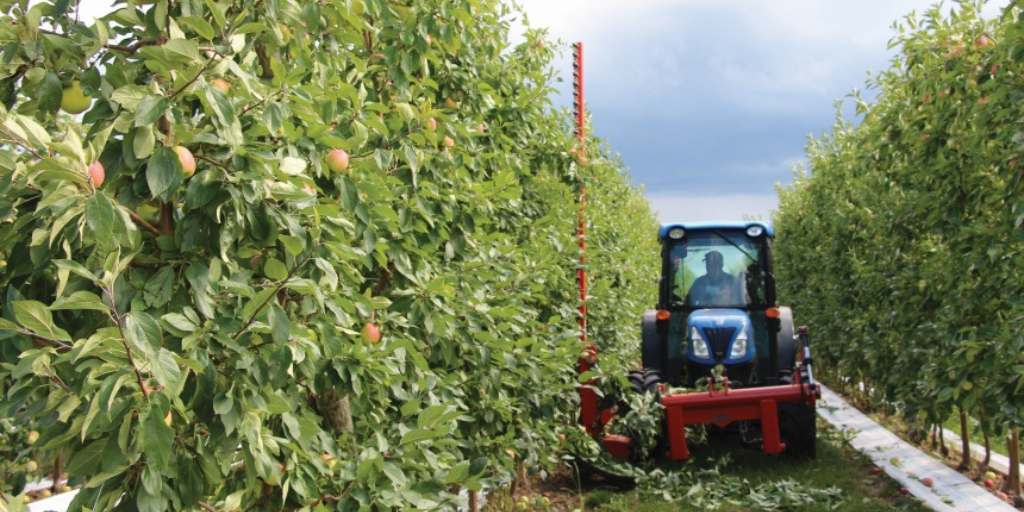This article is part 2/4 in our Apple Thinning series and will cover mechanical thinning processes, advantages and disadvantages, and the tools most commonly used.
Mechanical thinning is a horticultural practice that involves the use of mechanical devices or equipment to physically remove excess fruit or blossoms from trees during the early stages of development. As with all thinning methods, the primary goal of mechanical thinning is to optimize fruit size, improve fruit quality, and prevent over-cropping by reducing the overall fruit load on the tree. Mechanical thinning is often used in combination with chemical thinning to help reduce the need for spray applications or to reduce labor costs of manual thinning. Thinning has shown to have a positive effect on overall fruit yield, as even though the trees will grow less fruit, the fruit that is grown will be larger.
Mechanical thinning is commonly used in large commercial orchards where there is a need to manage fruit load efficiently for better fruit quality and overall orchard productivity. It is generally best suited for high density orchards, especially spindle/trellised growing style. The choice of mechanical thinning tool depends on factors such as the apple variety, orchard size, and the level of precision required. Growers may use a combination of these tools or select the one that best suits their specific orchard conditions and goals for fruit thinning.
Important Denfinitions:
Persist: when a fruitlet is still growing on the tree and is expected to become a harvested apple
Abscise: when a fruitlet has stopped growing on the tree and is expected to drop off before harvest
‘June’ Drop: the period of time in the growing cycle when abscised fruitlets fall from the tree after pollination. This typically happens in June in North American growing areas but timing will vary depending on the growing region.
Mechanical thinning is typically performed during or shortly after the bloom period, when the fruit is in the early stages of development. The exact timing depends on the specific variety and local growing conditions. Mechanical thinning works by physically dislodging or shaking off flowers or small fruitlets from the tree. The mechanical force applied triggers natural abscission, causing the tree to shed some of its developing fruits. Thinning as early as possible reduces competition and increases cell division and growth of remaining apples.

Mechanical thinning can happen at multiple times during a growing cycle. The earliest use of mechanical thinning happens before flowering when buds are developing for the season. Thinning potential flowering buds before they develop is the earliest opportunity to reduce the energy the tree spends on creating blooms for fruit that will not be harvested and will focus the tree’s energy on developing fewer blossoms.
The next opportunity for thinning happens when the tree is in bloom. The majority of mechanical thinning tools on the market target blossom thinning. Removing blossoms before they become fruit is another way to divert the trees energy away from setting fruit that will not be harvested. This allows the energy to be directed to further the development of the fruit remaining, and overall tree vigor. Mechanical thinning during bloom significantly reduces the labor costs of manual thinning later in the season, particularly on organic varieties where chemical thinning is not possible.
The last growing stage mechanical thinning tools are typically used is after the fruit has set and will knock off fruitlets. Again, this process brings the crop load closer to targets and helps to focus the tree's energy on growing larger, higher quality, apples. Sometimes mechanical thinning tools will be used after a spray has been applied to stop the growth of some of the fruitlets. After the fruitlets have stopped active growth, they are no longer using the tree’s energy but it is still important to remove them from the tree as part of pest management strategies and to get a more accurate assessment of the effectiveness of the thinning treatment. Post a thinning spray, or even the natural June drop period, mechanical thinning tools will help ensure abscised fruitlets get knocked off while the persisted fruitlets stay.
Mechanical fruitlet removal is also possible without chemical thinning although it is less common as it is harder to control which fruitlets will stay. Ideally mechanical thinning would remove fruitlets that are smaller and help to space remaining fruit evenly for continued growth, however most mechanical thinning tools on the market are not this precise. With some of the tools we explore in the list below, there is a danger that larger fruitlets will get knocked off first as they are heavier.

Mechanical Pruners:
Edward Mechanical Pruning Machine is a popular model for creating hedgerows in high density orchards. It uses rotating vertical blades to trim branches to a uniform depth along an orchard row. Using a pruner in this style allows for more effective use of the mechanical blossom and fruitlet thinning tools as apple trees are narrow enough for the machines to reach.
String Thinners:
Both the Darwin Mechanical Blossom Thinner and the Eclairvale Fruit Thinning Machine are examples of mechanical thinners that use a series of rotating strings or flails that gently touch the tree branches, helping to dislodge excess fruit. The rotational speed and height of the strings can be adjusted to control thinning intensity. These machines can be used both on blossoms and on fruitlets.
Robotic Pickers:
This style of mechanical thinning is still in development. With the ever increasing cost of labor, many growers are looking for robotic solutions to tasks previously only accomplished by humans. Agrobot is a robotic picking system that was developed for harvest, but has also been working toward developing tools for thinning fruitlets. This technology would allow for precise thinning and avoid harm to trees that is a hazard with the more traditional mechanical thinning tools.
The effectiveness of mechanical thinning can be influenced by factors such as the type of fruit tree, tree architecture, and the specific design and operation of the mechanical thinning equipment. Careful calibration and adjustment of equipment settings are essential to achieve the desired level of thinning without causing damage to the tree or remaining fruit. Many growing styles are not suited for mechanical thinning as the fruit or blossoms growing further inside the tree are not reachable. Mechanical thinning can be a more labor-efficient method compared to hand thinning, especially in large orchards. It allows for quicker thinning over larger areas. However, like other thinning methods, careful consideration of factors such as tree health, weather conditions, and the potential for stress on the trees is important to ensure optimal results.
Croptracker develops agtech solutions for industry leaders. Located in Eastern Ontario, Canada, our mission is to make crop production safer, more efficient, and more profitable. Designed in partnership with fresh market producers and distributors, every tool we create is based on direct industry feedback. Croptracker’s award-winning farm software optimizes recordkeeping, labor tracking, production and cost management. Our integrative Harvest Quality Vision technology offers instant empirical analysis of crop samples exactly when you need it. Optimize your harvest season with Croptracker’s customizable solutions. Visit Croptracker.com to learn more about our products and contact us for app based solutions.


